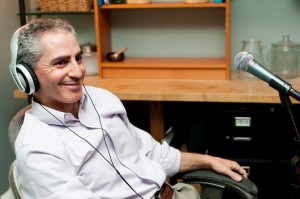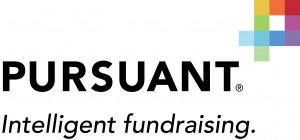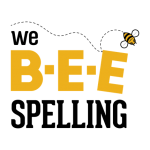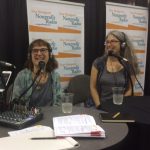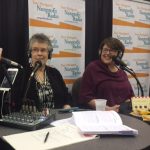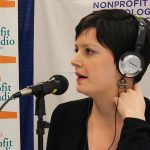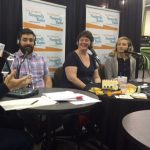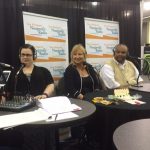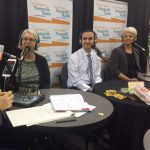Big Nonprofit Ideas for the Other 95%
I love our sponsors!
Do you want to find more prospects & raise more money? Pursuant is a full-service fundraising agency, leveraging data & technology.
It’s not your 7th grade spelling bee! We Bee Spelling produces charity fundraiser spelling bees with stand-up comedy, live music & dance. It’s all in the video!
Get Nonprofit Radio insider alerts!
Listen Live or Archive:
- On Fridays at 1pm Eastern: Talking Alternative Radio and tune in
- Listen to the September 23, 2016 archived podcast
My Guests:
Tom Hudson, Tak Fujii, Porsha James & Trevor Kale: Data Disruption
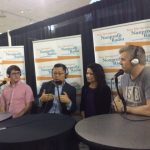
Our panelists share their wisdom on how to connect large data to untrained users. They reveal the tools they’ve used to prototype, wireframe, etc.; how to measure success; and lessons learned. They are Tom Hudson from thirteen23; Tak Fujii and Porsha James with Pancreatic Cancer Action Network; and Trevor Kale with Springbox. (Recorded at the 2016 Nonprofit Technology Conference)
Steph McAllister & Andi Argast: Small Data Rocks

Small data is the human-counted data you already have. Steph McAllister and Andi Argast explain what you can do with it and how to capture more. Then they leave you with the tools they use. They’re both with Framework Foundation and this is also from the Nonprofit Technology Conference.
Top Trends. Sound Advice. Lively Conversation.
You’re on the air and on target as I delve into the big issues facing your nonprofit—and your career.
If you have big dreams but an average budget, tune in to Tony Martignetti Nonprofit Radio.
I interview the best in the business on every topic from board relations, fundraising, social media and compliance, to technology, accounting, volunteer management, finance, marketing and beyond. Always with you in mind.
Get Nonprofit Radio insider alerts!
Sponsored by:
View Full TranscriptProcessed on: 2018-11-11T23:37:36.921Z
S3 bucket containing transcription results: transcript.results
Link to bucket: s3.console.aws.amazon.com/s3/buckets/transcript.results
Path to JSON: 2016…09…308_tony_martignetti_nonprofit_radio_20160923.mp3.459767683.json
Path to text: transcripts/2016/09/308_tony_martignetti_nonprofit_radio_20160923.txt
Hello and welcome to tony martignetti non-profit radio big non-profit ideas for the other ninety five percent. I’m your aptly named host. Oh, i’m glad you’re with me. I’d suffer the embarrassment of somnolent chea if i came to learn that you slept through today’s show data disruption, our panelists share their wisdom on how to connect large data to untrained users. They reveal the tools they’ve used to prototype wireframe, etcetera, how to measure success and lessons learned they are tom hudson from thirteen twenty three tak fuji and portia james with pancreatic cancer action network and trevor kale with springbox that was recorded at the twenty sixteen non-profit technology conference and small data rocks small data is the human counted data you already have. Steph mcallister and andy are gassed, explained what you could do with it and how to capture mohr then they leave you with the tools that they use. They’re both from framework foundation, and this is also from the non-profit technology conference tony’s take two. Don’t be in the woods, responsive by pursuant full service fund-raising data driven and technology enabled, you’ll raise more money pursuant dot com and by we be spelling super cool spelling bee fundraisers. We be spelling dot com hear from auntie si sixteen. We have our panel on data disruption. Welcome to tony martignetti non-profit radio coverage of sixteen ntc twenty sixteen non-profit technology conference. We are at the convention center in san jose, california, kicking off our coverage with a team of four tom hudson, tak fuji, portia james and trevor cale. They’re session topic is using digital disruption to elevate your cause. A case study, tom. Correct. Tax. Yes, portia. Yes. Trevor. Welcome morning. Thank you. Pleasure. We’re kicking off with you, it’s. All right, thank you. And portia is taking one for the team by standing, but, well, i’ve already reassured her it works. We’ve done it before. Not a problem. Okay, we’re talking about digital disruption. Now you have a you have a case that we were talking about? The pancreatic cancer clinical trial finder. Trevor let’s. Start down in with you. What was this case all about? I think we should start attack. Actually, pre-tax the owner of the whole shebang. Here’s. Okay, he’s got the best starts the first time. I forgot to do the proper introductions. Tak fuji is vice president of information technology. Pancreatic cancer action network. Portia james is senior manager of clinical initiatives at the pancreatic cancer action network. Tom hudson is technical director at thirteen. Twenty three. And trevor news not listed in here. Trevor is your what is your work? I’m the chief engaging officer at a company called springbox in austin, texas. Springbox dahna chief engagement officer austin, texas ntcdinosaur last year. Yeah, yeah. Now were, of course, the sanders. They were you there with that last year? I wasn’t few of us fear these guys work, but i was yeah. Okay. Porsche and tack. Alright, this is my third one here. Hat on. Okay. So best place to start with the case is with tom. Is that right? Now we attack with may attack? Yes. Okay. Acquaintance with the pancreatic cancer clinical trial finder case. Thank you. So about two thousand ten, the organization came up with the concept of gathering all pancreatic cancer clinical trials information across the nation to bring it into one comprehensive database. This allowed our internal patient services folks to then spread the word that there are alternative therapies for people afflicted with pancreatic cancer. There was such a great tremendous demand and need for this information that folks started pushing us. And so at from two thousand ten, we came up with the concept. We engaged tom trevor there, close to the mic and all of us. Or that came up with a concept of opening this thing upto the public. Okay, what kind of data set size are we talking about all clinical trials? You know that that’s portia at any one time, it varies a little closer at any one time. It varies for the number of trials, but we’re looking about one hundred sixty five trials at any one time that are available for pancreatic cancer patients. Okay. And what was our objective with this? A large data set of all these trials, what we we hoping to achieve? Sure. Well, for pancreatic cancer, the five year survival rate is eight percent. And one of the best ways for patients is to get involved in clinical trials that will help them just push the research forward and find better treatment options for this disease. So we opened up our clinical trial finder to the public in order, provide patients with real time access to clinical trials. That are available to them in their community. So many people have have preconceived notions about what clinical trials are, and we knew that this is the best way to push the science forward for this disease. Okay? And what is the first thing we need to do as we’re tryingto directly connect? Right? We’re trying to collect directly. Connect all this data. Two people who have the disease got cancer. What’s our first step in organizing this this endeavor? Well, yeah, sure. Every point to you. So you’re on with you. I got it. I got a confident about it. People point to you, you’re on. So so they approached springbox it’s, a agency in austin, texas, to help them bring this to the public. It was at its existing faze. It was only an internal tool, and the patients had to call in, and then they would access the internal tool via the employees that worked at the pancreatic cancer action at work. So in order to bring this public, we had to build a public facing interface for it. But we wanted to build the right thing, and so we really had to take the proper steps. Which meant, you know, doing some interviews with some of the stakeholders and actual patients and health care professionals that would be using the tool in order to make sure we build it, to be easy, we build it to be secure and to quickly connect them with trials in their area. Okay, so actually getting people who are going to be and users in focus groups, yeah, focus groups, interviews way wanna walk listeners through this process? We have about twenty five minutes to do it, so yeah, so focus groups, important focus groups, focus groups, and then and then from there we go ahead and start building what we call wireframes that turn into a prototype that we can actually test with people and make sure we’re doing the proper things in order, tio in order to get the information that they need and find any roadblocks that might be occurring. Twenty martignetti non-profit radio has george in jail. Everybody may not know what a wireframe is sure let’s wireframe is sort of a sort of a shell of what the actual final design and look and feel of the website would be with all the major functionality. There in place, but very flexible of that point to be able to make adjustments according to how the user would use the tools. Okay. Thank you. Quick, quick probation from drug in jail. Now, our surveys helpful. It’ll like at the pre pre-tax group stages. Is there any value in surveying? Did we dio any email surveys or anything like that? We had a general idea. So organization, we know our constituency very, very well. We knew through the years what patients were asking for what family members were asking for we also through our collaboration with medical professionals and pharmaceutical industry. We knew through the years what they were looking for. So they’ve been asking for years for access to our tools. Okay, so this has been a frustration point for your constituents for a long time? Yes isn’t asking pleading yes. Okay. Trevor kale, let’s bring you in here. What was your role in s o? Actually, the time of the initiation of the trial finer and that’s more or less current form technology, i was working with portion tack, a pancreatic cancer action network to sort of help to find the scope figure out we’re going to go and hand in hand with tom and the technology team it springbox i think piece of part of this is we’re talking about the process and where we go is the pancreatic cancer action network has been right, and what they do is being on the leading edge of technology and health care and what that means to providing resources to patients. Obviously they’re dealing with a segment of cancer that is much more aggressive than a lot of others out there, and so we have to move fast have to be smart about what we do and how we get there. And so one piece of this, you know, wireframes and prototyping and a lot of the visual designer research is a big piece of this, but i think part of the vision was taking the data that exists in spicing that in ways and making it more accessible that’s ever been done before you’re tuned to non-profit radio tony martignetti also hosts a podcast for the chronicle of philanthropy fund-raising fundamentals is a quick ten minute burst of fund-raising insights published once a month. Tony’s guests are expert in crowdfunding mobile giving event fund-raising direct mail and donor cultivation, really, all the fund-raising issues that make you wonder, am i doing this right? Is there a better way there is? Find the fund-raising fundamentals archive it. Tony martignetti dot com that’s marketmesuite n e t t i remember there’s, a g before the end, thousands of listeners have subscribed on itunes. You can also learn maura, the chronicle website, philanthropy dot com fund-raising fundamentals, the better way. Dahna on what we have today is as we start, you know, we’re iterating and it’s alive tool, and we’re optimizing and taking real time learnings, but what we’ve done, i think probably the leapfrog on anything else sort of in the same space is we have gone along yards the hard yards on slicing that data in a new way because i’m thinking this is very technical data research, trial data. We’re trying to siphon it down and make it user yes, simplified user friendly how do we how do we take on that kind of is this for you? Back-up how do we how do we do that? We actually from our sort of user acceptances and engagements and all the different inputs that we got, we pretty much knew that we just had to get the data to the individual that was goal. So we had to put a geographic sort of indicator or what we call a zip co finder alright, so ah, a new patient would come on to our website type in looking for a pancreatic cancer clinical trial type in the zip code it’s a simple is that in hit enter, i mean and then a list of pancreatic cancer trials within their zip code would pop up means that simple. And we took us federations to get to that simplicity. But that’s sort of the journey we went through that, yes. That’s the objective. Now, this jack make it that simple that’s, right? But that that data did take a long journey because i think in the beginning it existed purely at the pancreatic cancer trial finder office on a computer. And then from there, we went to the cloud. We use the rack space to be able to host that information, and they were a great partner and being able to get that information up and running and fast access. Okay, major, major background noise. That that’s fine. This’s real times live. Yeah, we’re in the exhibit hall and exhibits are still being set up. So whatever noise you may hear like that yeah. You know, it’s spartan parcel of setting up the exhibit floor before you all enter. So this is what happens you’re we’re covering it live. We got plates crashing, we got forklift so that there’s teaspoons we got a full tea set. Yeah, so? So then the data went into the cloud, and then we had to be able to take that data that was still being used internally by the pancreatic cancer action at work team to talk to people and individuals on the phone. We had to use that same data and publicly interface that for people to do searches on, and so we had to build what’s called an ap i interface and what that is is just a conduit to be able to take that data that’s internal and bring it live. Teo, a public facing website to be able to see on a website real time subsume to this conversation is you need technical help to do this to take a large data set, make it manageable for end users who are not technical technical people, right? We’re talking about trial data that was is written by professional by researchers, right by phds and researcher, not just correct. We’re trying to bring it down usability for people who have thank you out of cancer than more there or family member non-technical people so this can be done, but well, you need help even more challenging than that was that we had to bring it not only for non-technical people, but also for health care professionals, doctors, researchers and so they understand the technical parts of it. So we had to be able to interface to two audiences, technical and non-technical okay, let’s, see a little more about that, about having accessibility to multiple levels of sophistication around data. Who who can we could speak to how you how you organize that? Sure. So, yeah, so we already have the expertise in house that we take, you know, very dense clinical information, and we pare it down to lay lay language, essentially for anybody to understand with a high school education or even less and that’s really geared toward our patients and family members, we still keep it very technical and clinical for the health care professionals. So the challenge was to have this tool accommodate two very distinct groups of people, but tohave one tool to fit their distinct needs. And so we actually created to kind of entry points into our clinical trial finder to a comedy thes two distinct groups based on their level of expertise. We need some technical tools to help us to do all this who’s best to speak, to start, talk to the what some tools work, i can start it out well, from a from a programmatic standpoint, well, let’s even go back further to when we were starting to conceptualize thie piece, we use the tool called actor to be able to prototyping, and not only those those static wireframes be ableto bring those wireframes toe life toe where you could even put those on a website and be able to click around and then from there we quickly move teo html five, which is, you know, sort of the new protocol for front and web development, and that allowed us like to build those prototypes in html five and then take that same code and build out the actual tool using dot net at the back end structure and then host on rack space for all the cloud infrastructure way had to do a lot of scrubbing of the data, to be able to make that consumable to the patient and make them feel comfortable, you know? As portia said in the beginning of this session, pancreatic cancer, the survival rate is extremely low and not only that there’s very little time for these people, and so we want them to feel as comfortable as possible. And so we had to sort of taylor that content to be comfortable to them, to be able to quickly get to acceptance of, you know, the fact that they might be able to do a trial on be ableto end up maybe saving a life. Okay, we now i made us digress a little bit from our chronology. We were at the it’s. Fine. We’ll get back. We always come back as we rittereiser wireframe and and testing well, not testing a product, but early testing stage. What comes after we have feedback from the users. And of course, the users now, i realise, include technical medical staff as well as families and patients. What comes next is we started as they start to get feedback. We go, you know, into the next round of generation of revision implying obviously, the learnings we have starting to apply visual design based on, you know, brandeis lines and some of the cues that we take directly from the pancreatic cancer action network’s branding working with the, you know, marketing team as well, making sure that we’re expressing what that looks like in the right voice and tone. And then we start to layer content, strategy and actual, you know, calls to action and how this thing’s gonna look and work and feel to tom’s point we want this to be accessible. I think if you put yourself or try to put yourself in the shoes of somebody that may be, has just left the doctor’s office with this diagnosis, you know, you need a tool and you need to be able to get through it, and he needs to be not something that you don’t understand or too complicated to kind of use, so starting to apply content, strategy and visual designed to push the prototype further. This, tom said, studying to apply some of the front end’s, starting to build things in html five and starting to actually mold this thing into, you know, sort of a real version of the, you know, the first real version of what it’s going to really be using some, you know, dummy data and things like that to make sure it’s powered but that we still have some flexibility and ability be nimble along the way in that structure, and during this time i think i think one of the big important issues that tack sort of helped us understand mohr as an agency and we realize now is so important is security of that data and being sure that that layer of security is on their so that, you know, we’re not we’re not losing any kind of patient information, you know, these these people are putting up their information about themselves in a public facing way, and so we just want to make sure that that data is locked down and secure. So as part of that sort of security, we cognizant lee knew that we had to provide privacy. I mean, people are coming, they’re in a serious situation, and we went in to ensure them that their information that they provide was secure. So from the get go we designed, we actually went out to the market place, and we knew as a non-profit we could not bring on staff, we couldn’t tilt up servers, we couldn’t do this security, so we went out to the market place, and we selected rackspace. As that partner, that would build out the infrastructure and provide the security. The other thing is, as we built out the security infrastructure, one thing we also wanted to insure was performance. We wanted to make sure if the person’s on a pc laptop mobile device that this information was going to be quick and easy, so part of tom and trevor and porsche when their private providing the ease of use perspective, i was worried about performance because i needed this information be quick and easy and accessible and guaranteed to be up at all times across devices that surround responsive. Okay, attack. How long does this process take? From the time that you decided? Okay, we’re going to listen to these constituents who have been clamouring for this to the time you got something that you were comfortable putting out to the public and probably still continues to evolve. Probably never done. But you know from okay, we’re going to take this on two. We’ve got version one point. Oh, and it’s available to the public. How long was that? You know, my involvement came about three years ago. I was tasked to bring the clinical trial. Data based to the cloud. So that was the first thing i had to do. So that was the internal perspective. Our long term goal was to make it public facing. So keeping behind our firewall internally wasn’t goingto do that. So we had them move it to the cloud. So that was the first thing. Once we push the product to the cloud existing product, we built the security structure. We ensured that i was working properly. Then that’s when we sort of said, okay, springbox and team, how do we take the next step? How do we start? Prototyping duvette helping. And how long how long should people expect? Well, how long you know, just kottler project from that. It was from two and a half to three years at least. Yeah. And, um, yeah, i was gonna say portia probably dreams and gan charts. So she’s probably actually the best person teo tends to the question, but yeah. I mean, i think it was a couple of years and in depending sort of on the phases as we i went through in to find, you know, there was a lot of research. Obviously we had to be. Done. And once the research phase is out of the way, we were able to move quicker and other pieces. And yes, to your point, it still it still goes on. Okay, gant charts get yourself out of georgia. Everybody’s. Not a project. Project manager what’s a gamma man can’t explain it. It’s it’s, a line by line series of events that help you map out tasks across timelines. Okay, help. Shoretz shows dependencies to just dependencies and parallel deliver. But it has happened before. You know where you can happen. Okay, okay. Wait. We still have ah, good number of, you know, minutes left together. Let’s start too let’s say we start to move to success. I mean, our measurement, you know, you’ve got these two very different constituencies. Although very inter related. How do we know whether this has served their needs at version one point? Oh, not not today. When it was first launched, how do we start to get feedback? Sure, i’m so when we launched it to the public. I mean, feedback was instantaneous because the clinical trial finder is connected to our internal database. So as people are using the tool and requested information that would come into our cue on the back inside for us to interface with the patients. Our google analytics shows the traffic to the site. How many people are our visiting? How many people are completing searches? We have so far. It’s it’s, it’s coming on it’s one year birthday, thie end of next month so we’ve had so far sixteen thousand unique users, which is amazing. We have a lot of qualitative feedback from patients and families, they’re telling us that being able to use this tool has made him feel empowered, you know, for a disease that takes so much a way for them to be able to use something and feel like, wow, there’s actually options for me so many times, these patients are not being told of these options by their doctors, so to be able to go to their doctor with information and say, i found these trials that i could be eligible for help me connect to them. How are you getting this feedback from from patients and families? Surveys are calling your you interviewing a subset it’s actually a combination of all i mean, we’re on the phone with them daily, so we hear verbal feedback, we get written feedback, we have surveys, we have postcards. We just got a lot of, you know, just feedback that they practically sent to us to say thank you that we’re providing them hope we’re making them feel empowered. They’re grateful that we’re here for them. They’re grateful that they have access to this information and it’s, not something that we would have necessarily heard if we hadn’t provided this tool to the public. Yeah, of course you would not have. They wouldn’t have had access to it. Anyone else want talk about measurement? Course we can talk about. The national statistics are sort of success. Oh, yes. So for adult cancer patients for a clinical trial participation glow art nationally, it’s three to four percent. And what we’re finding with our program is that we’re seeing about fifteen percent of patients are reporting that there actually enrolling in a trial based on the information we’re giving them. So when you compare three to four percent nationally across all cancer types and for this disease fifteen percent, i mean it’s a significant significant improvement, and we’re really impressing the medical community for this disease to see, oh my gosh, like you guys were doing something that you were told could not be achievable, and we’re achieving it. How about some lessons? Learned? What? What didn’t go the way you expected to have to pivot? Maybe somewhere we haven’t heard from tom for a while? Yeah, i think a big lesson that we learned as an agency working with a company like the pink ah non-profit like the pancreatic cancer action at work is that, you know, this is like, like you said earlier, this is really, really complicated data and in order to do, you know, a top notch job, you’ve got to jump in headfirst and understand that data inside and out, and so there was so much work up front really getting to know all about, you know, all the different aspects, you know, i would say there was maybe two hundred data points across the data when you talk about patient information and when you talk about trial information and health care professionals, and we had to manage all of that data and make sure that everything is working smoothly. And so what was it, maura? Front time learning the data set. That lots of upfront times, but it’s, you know, understanding their process with the patients when they’re on the phone and the different data points that they’re collecting and what’s important to them and what’s not important to them, you know, the different parts of the tool that or the data that maybe they’re not using as much versus some of the data that’s crucial that we must track things like that. Another part of the experience that i thought was was pretty eye opening. And what sort of new for the day was doing mobile first design and so knowing that you know what way? Have vacuum cleaners now. Thank you. Exhibit floor car it’s so clean need to be clean. They need to be clean. So clean. That’s a vacuum. Wait. We could hear each other. Yeah. Yeah. It’s fine. So yeah. So this is one of the first protects. Well, first where? You know, we knew that within about a year and a half to two years the mobile traffic was going to surpass the death top traffic. And so we went ahead and designed ah, on a mobile first platform. So starting with the mobile phone. Doing that design and the working up to tablet and desktop from there ever anything lessons learned? Andi, i think it goes back to we learn new things every day. I think some of the parts that poor shows speaking to around success have been surprising and have really challenged us in what we do with the tool now that it’s live. And now that we’re iterating and optimizing, we have been known to bend and potentially break our own tool via demand. Oh, and that was something i think that, you know is it’s horrible problem, but sort of a great problem to have in some sense, right? We’re driving more people to this great resource. Oh, and that has been something that we’ve been working through. I mean, i think we’ve got some good solutions in place and have done so, but that was, i think, a surprise along the way as we went again, i think going back to that rackspace conversation, working with those guys to figure out like, how did we really just get ahead of this and solve it? But and there’s been a lot of things, you know? We’re talking about one system. That integrates were only one system, but it integrates with all of these other systems that are also all unique and very complex on. And so it sort of is, you know, we get into these positions where you want to add a thing or change a thing. Oh, and it’s not just a simple as adding or changing a thing, right? We’ve got to go into the source data, we’ve got to go into the the place where the data is output her story, we’ve got altum also alter those data sets and tables and structures and things like that. So a lot of sort of pandora’s box type problems along the way, but all all great learning’s to solve, and i think we’re getting more scaleable everyday, you know, a cz we continue to optimize oppcoll alright, attack. I’m gonna leave you with the last word. We just have about fifteen, twenty seconds. Vice president information technology of the organization that took this on. What would you like to leave listeners with if they’re anticipating a project like similar it’s? Really coming down to just teamwork amongst all the different agencies? All different parties involved keeping an open mind and really, really just communicating continuously because with this type of design and the need to get it out to the public, it had to be very rapid. And so there were times where tom and i are kind of at what’s going, wait, just go back and forth, but we’ve worked through it will come to a good conclusion. So it’s, just the open communication, teamwork, outstanding great way to leave it closest to me is tom hudson, and tom is the give me a clue, of course. Technical director of thirteen twenty three, then is tak fuji he’s, vice president information technology at the pancreatic cancer action network. Porsche james is senior manager, clinical initiatives, pancreatic cancer action network and please remind us. Trevor kale, you are chief engagement officer it’s springbox thank you very much. Thank you, thank you. Ready non-profit radio coverage of sixteen ntcdinosaur twenty sixteen non-profit technology conference thanks so much to you for being with us. Small data rocks coming up first pursuant, check out their fund-raising management tools. They fill your potential donor pipeline and keep your tasks prioritized and aiming toward your fund-raising goal. Their tools are smart, intuitive, easy. To use ideal for small and midsize shops pursuing to dot com, we’ll be spelling spelling bees for non-profit fund-raising this is not your mother’s spelling bee, not even your seventh grade spelling bee. They bring in concerts, dancing, standup comedy, fund-raising and there’s a spelling bee. Also, they’re very fun video shows it all at we b e spelling dot com now for tony steak, too, don’t be in the woods on plant e-giving there’s a lot that small and midsize shops can do to promote planned gif ts you’ve heard me say, and this is always true, you start any program when it was going to be huge or modest or tiny with bequests, charitable bequests, gif ts in your donor’s wills you might go beyond that, but you don’t need to a small midsize shop can have a very respectable plant e-giving program, just with requests, you can start and stop there planned e-giving there’s a lot of intimidation around it, and people consider it a black box because they scott terminology that it never gets explained to conferences unless you come to my sessions on. Do you think people think they need a lawyer or very sophisticated consultant not true, both of those are falsehoods. It can be a very big, valuable part of your fund-raising mix and you don’t need all that expertise. And you shouldn’t be intimidated by the jargon. I give you lots of ideas for getting started on planned giving in my video don’t be in the woods and that’s at tony martignetti dot com that’s tony’s take two the live listen love, you know it’s got to go out it’s coming every week, you know that live love to the many listeners who are out there right now fromthe cities and countries you know who you are right now, you’re listening and i thank you so much. I mean, now when we play now, then you’re playing. Then now you’re listening now, then latto to the show that then on, but we’re doing it now. But then that’s you the podcast pleasantries, they go out, they go out every week, right in the back of the live listen, love all those over ten thousand listeners pushing eleven thousand and sometimes actually, we peak it. Ah, little over twelve thousand, but on the average over ten thousand very grateful pleasantries to the podcast audience as vast as it is, and those affiliate affections to our am and fm listeners throughout the country, affections to you and your am and fm stations for carrying the show on their weekly schedule. Here we have. Steph mcallister and andy are gassed, also from ntcdinosaur welcome to tony martignetti non-profit radio coverage of sixteen ntc, of course, that’s, the non-profit technology conference, and also this is part of ntc conversations. We’re in san jose, of course, at the convention center, and my guests are steph mcallister and andy are gassed. We’re going to get to them very shortly. First, after highlight my swag item for this interview. It’s from firefly. It is a key chain with an led light and also a very powerful whistle standby. It’s actually still echoing i think the echo is done now. Ok, wei had this to the swag pile for the day and it’s in all right. Steph mcallister is the city is seated next to me. She’s, the manager of systems and impact reporting at framework foundation. And andy argast is national program manager and digital strategist for the tech razor program at the framework foundation. Ladies welcome. Thank you. Thank you for having us. My pleasure. Your seminar topic is forget big it’s all about small data. Andy let’s, start with you. What? This is not what we hear about. We don’t hear about small data now. Why are you causing trouble? Because, well, we like to be like to challenge things a little bit. Okay, so small data as opposed to a big data, really is all about the idea that organizations can use the data they’re generating everyday in the work that they do and small data is data that human countable it’s, actionable and it’s understandable by the organizations that are using it. We already have it way already. Haven’t we already have it? Yes, it’s all around us. And what we what we really wanted to talk about in the session today, and i think that we did is not only do we already have it, but we can put the infrastructure in place to actually do amazing things with it if we’re a little bit strategic voted okay, we’re going to learn about that of the next twenty five minutes. So anything you want to add step to the overview report? Sure. So one of the things you wanted to accomplish with this session was also doing people some hands on actual things that they khun dio to start collecting, collecting their small data, so getting them using tools that do a lot of this for them automatically, and so taking a lot of the burden off rather than saying small data zoho further burden on your on your organization. Okay, well, let’s, jump in. What? What, what, what? What types of data are we talking about? That we already have that we should be using. So it could be something as simple is how many volunteers you have on staff and it’s it’s? Odd. Especially if you have a medium sized organization. You might not know these kinds of numbers off top. Of your head, or what percentage of them do a particular type of work for the organization or knowing what your top ten donors are at any given time in real time? S o that kind of information is coming in to you through c s v s and excel files, which might be complex and are being analyzed. But you have it there, and you can do some pretty simple things to get that information. What amount of that you’re just gonna know off the top of your head. Something like like the donor. David, you know that information who’s your top ten donors? Depending on your job in the organization, you may very well be able to recall that in your sleep, you may. You may be able to, but you would be surprised, especially in real time. You know, you might have a lot of donors coming in and a different basis. And you might think, you know, that’s. Okay. Yeah. So and you know that you might think that you know those top ten and you make a good point that you, depending on your job, you might know that. But having something like an organizational dashboard, where myself in sort of a night position, might have access to that information as well. So there’s this kind of openness, even within the organization for everybody have access to this information numbers, not just the specialists like organization. Andi, what can we do with this? Well, there’s a lot that can be done, i think, though, that i just wanted to take, like, a little step back and sort of turned to my earlier point because there was something that i forgot to mention with chaillou that when we talk about small data, were sort of what we want to do is demystify that term because there’s so much buzz around the idea of big data, and i think that what set small data part is that, you know, unlike big data where you need a machine typically to process and you’re talking about petabytes exabytes of data, which is huge, and obviously, no one person could do that small data is the, you know, it’s stuff was saying it’s in those excel sheets, and it might be top of mind, but it really is that sort of tangible, you know, information and data that were that. Were working with, and i think that so to as to go back to your question, what we can do with it is sort of anything that you want to do with it to achieve the goals of your organization. It really depends on what kind of knot for-profit you’re working at and what sort of strategies and objectives you have in place. So we try to be a little bit technology chick about that in terms of saying you should or shouldn’t do this with it, rather just saying what? What is it that you want to ultimately achieve and then work back from there and set up the infrastructure and put the processes in place so that you’re collecting that data to to achieve those particular goals? Ok, so we should start with our goals then andy, what is it? What is it? We’d like tio have people be aware of what outcomes we would like to measure. So we start with our goals. Okay? Differently. Okay. Okay. Once we have our goals in place than well, then what? We identify the data that is going to help us get there. Absolutely. I think. It’s what am i? Doing the right track, you know, this is this is perfect. So so what it is is it’s ah, thank you with a data dummy perfect train him in the next twenty minutes. Eso what were and that you know, our target with small data’s people that may not have the level of data literacy that they think they need to have, and it really makes that accessible. So one thing we want to do is get him thinking about a systems overhaul. So as much as we’re saying this is small data it’s, actionable, it’s easy, it does involve a transformation of the organization, and one of the things is getting your team together to decide what those data points are. What do you actually need to collect rather than falling back on? We need to collect absolutely everything, or we’re overwhelmed, and we’re not going to collect anything s o bringing those together for us. The first up to the system overhaul is taking on cloud computing tools who, by and large, we’ll focus on collecting these small data points and making it really easy for you to report on them. So it made it may not be you know how we’re going to collect this data ourselves, but what tool allows us to do that? So instead of selling tickets by email, were going to use an online ticketing tool where we can export all of our ticket sales? So some of these air are smaller, easier changes to make, but that’s what we’re recommending as a starting point, okay, using tools to capture the data, absolutely being thoughtful, but at the start of a program or project rather than at the end, when you’re funders asking you, you know, how many tickets did you cellar, you know, maybe that’s something that basic, but any data point they’re asking you for? You planned to capture that before you even started the project. Okay, do you have some recommendations for different tools that way can be using for capture? Absolutely. So we do, depending on what you’re trying to capture something like, i guess i’m bringing up tickets so things like eventbrite, our universe, which was recently acquired by ticketmaster. A lot of those have freemium options. Eso freeman just means that you have a free option and especially if you’re a small organization to use them if you’re wanting, teo capture even basic data using surveys, survey tools for things other than simple, like feedback surveys is a way to get other people to do your data entry for you. So if you have volunteers coming into your center and you want to capture data, getting them to fill out a simple form like a google form or surveymonkey is a sign in that will structure your data for you in ways that are really simple and actually free in those andy anything, any data captured tools you want toe? What ad? I think steph covered off a lot of them we use in our own work. We do use the google suite a fair bit because it is available as a free free for not-for-profits or registered charities on we really said we try and sort of being a listing about the tools, whatever works for a particular organization, but we really do encourage people to pick tools that are cloud based, but also to think about where it will get them in a couple of of years because technology changes quickly and we want to ensure that in, you know, five years down the road. That they’re not going to be saddled with something that they can’t export their data from, for instance, that there is sort of like in is an escape plan, and staff has always found of saying that she has an escape plan for all of the tools that we work within our own organization, which i think is a good idea to talk about the escape plan in one second. I just want people know that that was not god speaking way have we have not embodied him or it where the were in the convention center at ntc? That was an announcement, i think about lunch people queueing up so important running it was nothing more, nothing more independent than that. It was just a lunch announcement, okay, what about the back door escape? Non-cash whatever you’d like, tio and every kind of okay escape hatch, so this escape so escape hatches. So one of the benefits, as is and he said, is we really like people to use cloud computing. They’re often affordable, theirs, they’re rapidly expanding and changing and, you know, great things there is coming out. They often talk to each other, so data transfer is great. But one of the downsides is, you know, a lot of these air small start up sometimes, you know, a company’s fail and succeeded different levels. So it’s. Good. You know, if you have any of these tools knowing how you will move to a new tool if if something better comes out okay. So, you know, before you purchase saying okay, what is my worst case scenario? This whole company goes under? I’m not using this cloud to anymore. What is my action plan to get us, you know, onto a new platform onto a new tool. Not to say that that kind of thing happens often, but it’s, good to prepare for that when you’re living in a really fast paced technology could say it’s a part of your your disaster recovery plan. Exactly. Risk-alternatives recovery. Okay, okay. All right. So that we were the capture. St wei had some tools for capture. What? What else should we be thinking about in a small daily s o thinking about how to communicate the data effectively share it had a share in the organization outside the organization. And both, yeah, funders, but also leadership thunders leaders. Whoever donors for us, it’s really important the general public understand the transparency of our organization, so we actually have our data from we have largely centralized database of all of our program stats, we share that in real time on our website that’s something we encourage other people to dio but making it whenever you’re communicating externally, making it accessible to people. So when we talk about data literacy, understanding your audiences, various levels of data literacy, so some of the recommendations we gave it our talk were things like, you know, is this tweet herbal, if you ask your mom about this chart of the stats, are this data she understand it? Or, you know, somebody that’s not steeped in your organization? Can they understand and get something from sharing any other about some of this sharing tools that framework foundation is using? So we use a lot, but i think i want to make a point about sort of about the quality of the data as well as it relates to communicating. So i think we’re talking about, you know, ways that you can communicate it but it’s really important for organizations to consider the share ability or the openness of that data sort of as a characteristic of the data itself, so if you’re thinking about different types of data, some data, you don’t want to share it all, so that would be like hr data or personal data, like anything that’s person identifiable, you’re not sharing that within the organization, but once you move into the realm of share data, so stuff you’re going to be sharing with stakeholders, like using some of the tools that staff mentioned, then you want to start thinking about how you can share that, and then sort of the furthest end from close data would be the idea of open data, so releasing, you know, sets of data for other people to reuse. So, like any of the tools, that could be that so using share data, for instance, could be any of the infographic tools we use picked a chart at our own organization chart, picked a chart like a with a k s o the nice thing about picture chart is that you can connect it to google sheets and so it’s seth is mentioning the idea of updating data in real time, so instead of just watching numbers change in a spreadsheet that you can watch her change. Excellent. Okay, so it sort of it pushes it sort of not it’s typically not immediate, but sort of it, you know, cycle through every few hours, and then you’ll see those turns. Actually. So for instance, if you had people, you know, sending you a customer satisfaction surveys you, khun see those charts, like how many people you know, actually gave your session. Ah fei, vote of ten are the ten out of ten. You can see those charts updated in real time, which is pretty exciting for small organizations that want to prove the sort of impact that they’re having in a particular community to say, like a thunder, for instance, you don’t have to, you know, wait till the end of the year to give them more report. They could be like, oh, you can just, you know, hop onto the website and take a look right now, okay, excellent. Other tools that you’re using it the framework. So what about anybody? Well, we use a lot of use somebody tio we’re sharing stage. Okay, so as far as that s o r centralized database is sales force, so we use a tool and there’s a lot of sales force people here or people that use sales force. We use a tool called cloud h q. And what that allows you to do is take what is essentially closed data at the time, it’s any of your internal database information and pull reports sales force and put that onto something like google sheet that that can be represented through something like picked a chart info. Graham is also a version of picked a chart that’s really useful, but i’m in a programme in program so it’s out of info gr dot a m info graham s o there also a really great one, but it’s finding those tools that help you bridge between where the data is being stored so on our cases salesforce database to whatever tool using to visualize it and those air examples of doing that in real time. You also can do that really inexpensively with excel like anyone’s who’s, a really great excel user and and understands formulas they can take those reports and make them into really beautiful visualizations that maybe aren’t real time but are really impactful on useful. So no matter what your skills that is there some really great visualization tools, okay, no, what else? What else would we be talking about? Capture sharing what else we got think talking more about a little bit about how to use these sorts of things that interns internally, not just externally, okay, so we tend to focus on you know, we have to prove to funders or stakeholders how well we’re doing in our successes, but we don’t talk about using these to make cases to each other so internally, so but between departments or two decisionmakers, you’re bored and how you can use visualizations to get them interested on dh for us. The example we gave in our session was actually using visualizations and, in our case, a dashboard to make the case for small day that your organization so actually using a small data example to to sell the idea that you need to make an infrastructure investment by organization to do this kind of small data capture. Like what you’re hearing a non-profit radio tony’s got more on youtube, you’ll find clips from stand up comedy tv spots and exclusive interviews catch guests like seth gordon, craig newmark, the founder of craigslist marquis of eco enterprises, charles best from donors choose dot org’s aria finger do something that worked and they are levine from new york universities heimans center on philanthropy tony tweets to he finds the best content from the most knowledgeable, interesting people in and around non-profits to share on his stream. If you have valuable info, he wants to re tweet you during the show. You can join the conversation on twitter using hashtag non-profit radio twitter is an easy way to reach tony he’s at tony martignetti narasimhan t i g e n e t t i remember there’s a g before the end he hosts a podcast for the chronicle of philanthropy fund-raising fundamentals is a short monthly show devoted to getting over your fund-raising hartals just like non-profit radio, toni talks to leading thinkers, experts and cool people with great ideas. As one fan said, tony picks their brains and i don’t have to leave my office fund-raising fundamentals was recently dubbed the most helpful non-profit podcast you have ever heard, you can also join the conversation on facebook, where you can ask questions before or after the show. The guests were there, too. Get insider show alerts by email, tony tells you who’s on each week and always includes link so that you can contact guest directly. To sign up, visit the facebook page for tony martignetti dot com. I’m jonah helper, author of date your donors. And you’re listening to tony martignetti non-profit radio. Big non-profit ideas for the other ninety five percent. So okay, so creating a dashboard to make the case for free dashboard there. Exactly. So what we did was we and we do this a lot of organization is, you know, when we want something, we’ll hack it together until someone else makes it. So what we said is you have fractured data set that your organization, i know you have excel files and you have, you know, things that you can export from tools you’re using and but you don’t have a dashboard and also dashboards i find, especially with aids and boardmember is a love that idea they’re coming out of oftentimes of business, intelligence, environment where those air really powerful so what you can do is it again, it may not be real time. It may not be the final product that you want, but you can turn those into what we did is actually used google sheets to create it that dashboard with some images, some numbers, some comparisons and put that together and said, you know, this is something you guys can put together show to your board showed your executive director and say, you know, this is the kind of, you know, in business intelligence we can have about organization and andy, what kind of reaction did you get when you did that? So it was really interesting, so we ask for a show of hands, esso. Before we presented the dashboard, we asked for a show of hands who thought that they had fractured data, so thinking about, like data, that silo door kept in separate buckets and sew it more than one day to source it’s actually not talking to each other. So you have isolated on a spreadsheet for exactly on a spreadsheet, or even having you noah database for donors and a database for your volunteers and not having any correlation, because sometimes your donors might be your volunteers on, and we had an overwhelming majority of people in the room raise their hands when we ask them if they had fractured data sets. So i really think that the idea of a dashboard resonates with people because, you know, i mean, who doesn’t love, you know, graphics, individuals and being able to sort of see everything right in front of you. But i think that there’s quite a lot of power and having sort of an overview of thie information that’s flowing in into and out of your organization rather than sort of having to go t chase it down. And so what we presented is a it’s a you know, open source template. Anybody can go in, we give them the link. They can go in and repurpose it. The formulas are all in there, so all they would need to do is paste in their own data. And they could actually just create one were away. So how could we share that with listeners? Is that possible? So we have a bit late for that? A bentley so that its bit lee forward slash small data dashboard and that’s all want lower case. So bentley forward slash small data dashboard. All data dashboard. Okay, excellent. So there’s a template? Yeah, right. What was the reaction at framework foundation to the dashboard that you cobbled together? Uh, so we weigh this wasn’t one. We actually used test data for this. So we didn’t use our own way. We do use dashboards at our organization for a multitude of i mean, when you were trying to make the case for small data at framework foundation, what was the reaction tell your to your pitch were pretty data informed, i guess i would say organization s o we’re pretty lucky in the fact that even though we are quite small that we do work entirely in the cloud that that we know don’t really need to sell it that hard. I think more it’s less an idea of selling the idea of small data and more the idea of just creating that, that culture in the organization where people know that, for instance, if it’s not in sales for us, which is which is our database, it doesn’t exist, so making sure that those work habits are in place because, even though did it doesn’t form our overall program objectives it’s hard to sort of injured that everybody is working in the same way we’re all individuals way inherited it from our founder thiss idea, like he was very much a pioneer in the nonprofit sector in canada, especially in this in this space, so we encourage that through the tag razor program to other organizations. So we we’ve been at the organization about three years or so, so we haven’t had to make the case, certainly for new employees, we often make the case when we’re introducing them to our philosophy as an organization, but no, we’re very fortunate in having not had to make thie case ourselves. Okay, okay, i understand back-up we’re talking about a good number of things, any other tools that we should be should be sharing the people i think you have tons of resource is right. I mean, i love the template for the way we get a few bentleys and in their presentation, what else? What else could we share with listeners? Other tools? Resource gosh, that there’s there’s so many wonderful tools out there on dh there’s, lots of great organizations that curate those tools for you. So tek soo who’s, a big sponsor here that people should be familiar with great place to go to first, they do a great job of organizing if you know the type of tool that you want to go out, but yeah, i really think the best advice i’d give is less an actual tool as an approach to tools don’t look for tools that air just for non-profits look for tools that and that are available to anybody and find out how. They can work at your non-profit. Okay. Okay, andy, anything about tools? Resource is you want to share. So i guess the only thing that always pops mine because it’s, a personal favorite of mine, is that there is an open source tool called raw raw. All right, w yeah. And i believe it’s raw dot i oh, i want to say, but that’s, right, i think, which is an open source data visualization tool and creates really, like, quite sophisticated and beautiful data visualizations with almost no riel data visualization skills required. And you can just take a data sheet and pasted into into the web site, and it doesn’t save any of your data. And then it gives you a bunch of different parameters to choose from and you can create, like, really good looking, like super cool data visualizations in, like, five to ten minutes. This is amazing, like, like, like infographics. So these are more like if you think about the like, you know, the scattered charts and, like, it’ll show, like the different sizes of the data balls and that sort of thing. Word trees, thes heir not the right terms because i’m not a data visualization expert, but definitely more on the actual viz lizzie’s inside, then an infographic so less a story that’s illustrated with pictures, but more like a genuine representation of your data in a visual form. Okay, wrong rock, and embed a bull on your website, which is really great if you want to share those insights. Oh externally definitely embedded it’s, an italian organisation, i think our coalition that’s put it together so oh, and tableau as well, which you didn’t mention. So missed to not mention tableau or tableaux public last shot. Go ahead, go ahead so tableau again, much more targeted towards statisticians, but really great. If you want to do mapping visualizations, google maps a cz well, you could make your my maps through google, so if you’re wanting, if you’re coveting anybody’s sort of map of their stakeholders or their engagement, you can do some really simple up loads of cs fees and have it sort of rendered onto a map. So if you want to pinpoint same member organizations of your non-profit, you can do that as well. So those two tools are great and tableau you could get a really great rebate through. Texas, which coming there’s a ton of stuff you could do with mapping the density of your donors? Absolutely. Of your volunteers, population centers of your donors around your different offices. Yeah. Okay, yeah. Blow tableaux and my maps. So that’s under google and yeah, and there’s really great. If you’re using wordpress, there’s, some great plug ins where you can style eyes those google maps, they don’t look like google maps so you can fool people into thinking it’s something that you magically coded yourself, which is that many of those plug it. The names are escaping me. But if you go teo wordpress huggins for my maps or google maps there’s, several really great ones and there’s examples to see what could work for you. Alright, excellent. Great. I love all the resource. We’re gonna leave it there. Great. Thank you very much. Thank you. Mcallister. Steph is manager of systems and impact reporting at the framework foundation. And also if the framework foundation is andy argast she’s national program manager and digital strategist for the tech razor program there. This is tony martignetti non-profit radio coverage of sixteen ntcdinosaur non-profit technology conference. Thank you so much for being with us next week, boost revenue with donorsearch vase and discovery visits. If you missed any part of today’s show, i beseech you, find it on tony martignetti dot com. Responsive by pursuing online tools for small and midsize non-profits data driven and technology enabled. Pursuant dot com, and by we be spelling supercool spelling bee fundraisers, we be spelling dot com. Our creative producers, claire meyerhoff. Sam liebowitz is on the board as the line producer. Gavin dollars are am and fm outreach director. The show’s social media is by susan chavez, and this music is by scott stein. Be with me next week for non-profit radio. Big non-profit ideas for the other ninety five percent. Go out and be great. What’s not to love about non-profit radio tony gets the best guests check this out from seth godin this’s the first revolution since tv nineteen fifty and henry ford nineteen twenty it’s the revolution of our lifetime here’s a smart, simple idea from craigslist founder craig newmark yeah insights, orn presentation or anything people don’t really need the fancy stuff they need something which is simple and fast. When’s the best time to post on facebook facebook’s andrew noise nose at traffic is at an all time hyre on nine a m or eight pm so that’s when you should be posting your most meaningful post here’s aria finger ceo of do something dot or ge young people are not going to be involved in social change if it’s boring and they don’t see the impact of what they’re doing so you gotta make it fun and applicable to these young people look so otherwise a fifteen and sixteen year old they have better things to dio they have xbox, they have tv, they have their cell phones me dar is the founder of idealist took two or three years for foundation staff sort of dane toe add an email. Address their card. It was like it was phone. This email thing is fired-up that’s, why should i give it away? Charles best founded donors choose dot or ge somehow they’ve gotten in touch kind of off line as it were on dh and no two exchanges of brownies and visits and physical gift. Mark echo is the founder and ceo of eco enterprises. You may be wearing his hoodies and shirts. Tony talked to him. Yeah, you know, i just i i’m a big believer that’s not what you make in life. It zoho, you know, tell you make people feel this is public radio host majora carter. Innovation is in the power of understanding that you don’t just put money on a situation expected to hell. You put money in a situation and invested and expect it to grow and savvy advice for success from eric sacristan. What separates those who achieve from those who do not is in direct proportion to one’s ability to ask others for help. The smartest experts and leading thinkers air on tony martignetti non-profit radio big non-profit ideas for the other ninety five percent.
